20 Marijuana Facts for 4/20
Today is April 20th. For many, it's not unlike the other 364 calendar days throughout the year. But for the cannabis community, it's something special. It's a day where marijuana retailers, consumers, and enthusiasts celebrate the cannabis plant and the industry's culture, often by consuming or smoking the product, which can be done legally now in a number of states.
According to an explanation offered by CNBC, the origin of "420" is believed to be related to a group of students at San Rafael High School in California. As the story goes, a friend's brother was growing cannabis in the woods at Point Reyes but was afraid of getting caught, so he drew a map to the cannabis plot for the teens to find and harvest. Though the teens never found the grow site, they would meet after school and football practice at 4:20 p.m. during the fall of 1971 to smoke a joint, prior to venturing out for the unfound plot. It was noted that "420" was commonly found in the group's private lexicon. From there, the cannabis consumption term took on a life of its own.
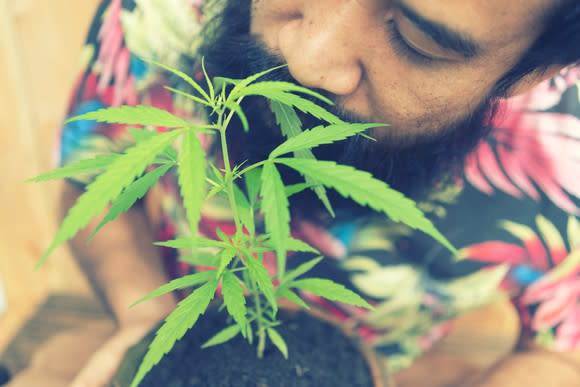
Image source: Getty Images.
Of course, a lot has changed since 1971. Today, on 4/20, we'll take a look at 20 marijuana facts that cannabis enthusiasts and investors should know.
1. The American public overwhelmingly supports legalization
To begin with, the public's perception of cannabis has changed in a big way. Back in 1995, the year before California became the first state to OK physicians to prescribe medical cannabis, support for nationwide legalization stood at just 25% in Gallup's survey. By October 2017, favorability to legalization had vaulted to an all-time high of 64%. In total, five national polls over the past year -- CBS News, Gallup, Fox News, Pew Research Center, and Quinnipiac University -- all show overwhelming support (59% to 64%) for legalization.
2. One group still opposes the legalization of marijuana
Still, not every group has a positive opinion of marijuana. Seniors aged 55 and up were still against the idea of legalizing cannabis back in October 2016, according to Gallup. However, their opposition to marijuana as a group has lessened over time. Between 2003 and 2005, just 29% of seniors 55 and over supported legalization. By 2016, this figure had risen to 45%.
3. The cannabis industry is growing very quickly
Few industries are growing with the swiftness and consistency of legal cannabis. According to research firm ArcView in partnership with BDS Analytics, North American weed sales jumped 33% in 2017 to $9.7 billion and are estimated to grow by 28% annually through 2021 to nearly $25 billion. By 2027, ArcView is forecasting around $47 billion in annual North American sales.

Image source: Getty Images.
4. The weed industry is a massive job creator
Sales aren't the only thing growing like a weed. Data analytics firm BDS Analytics calculated that 121,000 people were employed by the U.S. cannabis industry in 2017. By 2021, it's projected that 292,000 people will be directly or indirectly employed by the pot industry. That's a compound annual jobs growth rate of 25%!
5. Nearly three-fifths of the country has legalized weed in some capacity
All told, 29 states have legalized the ability for physicians to prescribe medical cannabis to patients, with nine states allowing the use of recreational cannabis. The most recent to do so, Vermont, became the first to approve adult-use weed through the legislative process -- i.e., without residents voting on a measure.
6. Two dozen states work entirely through the legislative process
Getting marijuana on the ballot isn't as easy as you might think. Though 26 states work through the initiative and referendum process (I&R), which can ultimately allow voters to decide if pot should be legalized in some capacity, 24 states do not offer the I&R process. In other words, in two dozen U.S. states, it's up to state legislatures to act and pass cannabis laws.
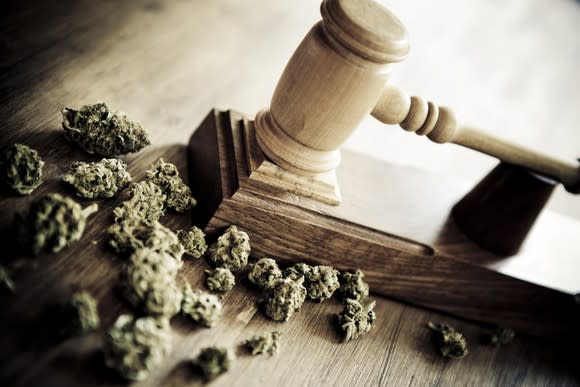
Image source: Getty Images.
7. THC and CBD are completely illegal in only four U.S. states
Even though 21 states haven't given the green light to physicians to write prescriptions for medical weed, 17 of these remaining 21 states do offer cannabidiol (CBD) oil or low-tetrahydrocannabinol (THC) products to patients by law. CBD is the non-psychoactive component of cannabis often noted for its medical properties, while THC is the psychoactive agent that gets you "high." The only four states with no marijuana laws on their books are Idaho, South Dakota, Nebraska, and Kansas.
8. The black market is still massive
Despite its rapid growth, the underground market for marijuana remains huge. In 2016, ArcView estimated that legal weed sales in North America totaled $6.9 billion. Comparatively, black market sales accounted for $46.4 billion, or 87% of the North American market. Though this figure is expected to drop as more states and countries open their doors to legalized cannabis, it's a reminder of the importance that underground sales still play.
9. The very first cannabinoid-based drug could be approved by the FDA in June
With the case for medical weed growing, this could be the first year we witness a cannabinoid-based drug approval by the U.S. Food and Drug Administration (FDA). GW Pharmaceuticals' (NASDAQ: GWPH) experimental CBD-based drug Epidiolex is currently under review by the FDA, with a decision date on or before June 27. GW Pharmaceuticals' lead drug handily met its primary endpoint of a statistically significant reduction in seizure frequency from baseline in two late-stage clinical trials each for Lennox Gastaut syndrome and Dravet syndrome (rare forms of childhood-onset epilepsy).
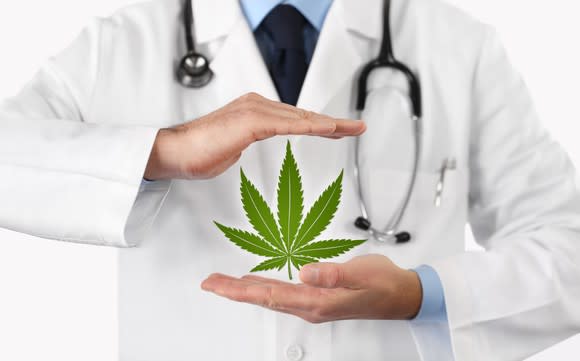
Image source: Getty Images.
10. Marijuana overdoses don't lead to patient death
The use of medical marijuana has also been suggested as a solution to the opioid epidemic in America. Even though it is possible for a patient to overdose on cannabis, no patient deaths tied to weed overdoses have been reported in each of the past few years. Comparatively, about 115 Americans die each day as a result of prescription opioid overdose-related deaths.
11. Canada is on the cusp of doing something no developed country has ever done
The U.S. could, in theory, be the most lucrative marijuana market on the planet, but that title currently goes to Canada, which is on the verge of becoming the first developed country in the world, and only the second country overall behind Uruguay, to legalize recreational pot. With a Senate vote scheduled for June 7, and all of its ducks seemingly in a row, Canada looks like a near lock to legalize adult-use weed by the summer.
12. Cannabis prices usually fall post-legalization
Interestingly enough, though historical data is limited to just a few states, cannabis prices have a tendency to fall post-legalization. In February 2017, CannaSaver.com CEO Brian Shapiro reported that wholesale legal weed prices plunged 60% in 2016 from $2,500 per pound to $1,000 per pound. In Washington state, wholesale weed plummeted from almost $25 a gram in August 2014 to approximately $6 a gram by October 2016. In other words, as supply rises and the euphoria of legalization wears off, prices and gross margin tend to head lower.
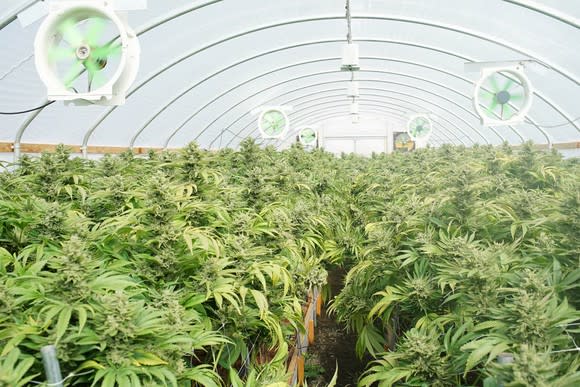
Image source: Getty Images.
13. Canopy Growth is set to become the largest producer in the world
With Canada knocking on the door of legalization, growers are expanding at an unbelievably quick pace. Perhaps none more so than Canopy Growth Corp. (NASDAQOTH: TWMJF). Canopy Growth already has seven facilities spanning 665,000 square feet of growing space and is constructing additional grow farms on 3.7 million square feet of land in British Columbia. Though it has not been forthcoming with an annual production figure, an annual yield of more than 300,000 kilograms is a real possibility for Canopy.
14. Cronos Group became the first pot stock to uplist to a major exchange this year
Another "marijuana first" in 2018 was the uplisting of cannabis investing company Cronos Group from the over-the-counter exchange to the Nasdaq. This move to a more reputable exchange should work to improve visibility and investor liquidity. It may even put Cronos on the radar of Wall Street's institutional investors.
15. Only a small number of countries have approved global weed exports
Though more than two dozen countries around the globe have OK'd the use of medical cannabis for patients, very few countries allow growers to export cannabis to foreign markets. Canada and the Netherlands are the only two to have already done so, with Australia and Israel laying the groundwork to begin exports at some point in the future.
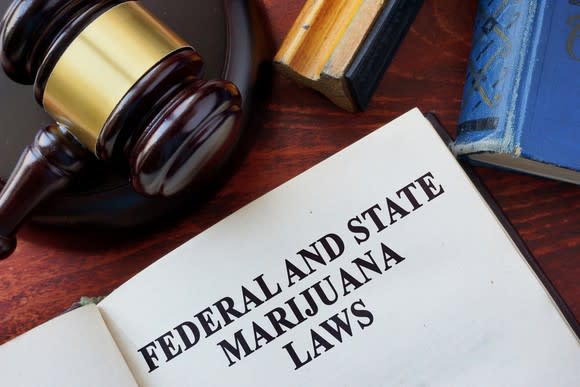
Image source: Getty Images.
16. It's a schedule I drug (and that's not changing anytime soon)
It's probably also worth driving home that marijuana is a Schedule I drug in the U.S., meaning it's entirely illegal and put on par with heroin and LSD. It's also considered highly prone to abuse and having no recognized medical benefits. This scheduling is unlikely to change anytime soon, especially with Attorney General Jeff Sessions attempting to wage war on the domestic cannabis industry.
17. U.S. cannabis-based companies pay an absurdly high income-tax rate
Because cannabis is federally illegal, businesses that operate in the marijuana industry are prone to disadvantages. Profitable pot companies in the U.S. are likely going to be subject to a more than three-decade-old tax law known as 280E. In short, this tax code disallows businesses that sell a federally illegal substance from taking normal corporate income-tax deductions, exposing profits to an effective tax rate of up to 70% to 90%! Ouch!
18. There's just one approved federal grow facility in the U.S.
The United States' Schedule I classification for weed also hurts medical research and patients. Because of the inordinate amount of red tape surrounding clinical research, there's just one growing facility in the U.S. where federal cannabis can be grown -- the University of Mississippi. Though numerous proposals for new grow facilities designed for federal research have been submitted, Sessions has, thus far, ignored those requests.

Image source: Getty Images.
19. A Schedule II classification may be even worse for the pot industry
Interestingly, rescheduling marijuana to Schedule II -- i.e., making it legal and admitting it has medically beneficial properties, but also recognizing its potential for abuse -- could be worse than its current status. Schedule II drugs fall under the very strict control of the FDA, which could regulate marketing and packaging, tightly oversee production and manufacturing, and even require companies to run costly and time-consuming clinical studies to prove medical benefit claims.
20. President Trump backs states' rights
Last, but not least, we learned recently that President Trump supports the rights of states to make their own choices on cannabis without federal interference. In January 2018, Sessions rescinded the Cole memo, which was a loose set of rules that states would abide by in order to keep the federal government off their backs. In doing so, Sessions opened the door for state-level prosecutors to bring cannabis charges against businesses and individuals at their discretion. Trump's latest promise suggests he backs the idea of states' rights in deciding state-level cannabis laws.
More From The Motley Fool
Sean Williams has no position in any of the stocks mentioned. The Motley Fool recommends Nasdaq. The Motley Fool has a disclosure policy.

 Yahoo Finance
Yahoo Finance 